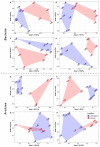Deciphering the Assembly Processes of the Key Ecological Assemblages of Microbial Communities in Thirteen Full-Scale Wastewater Treatment Plants
- PMID: 30996148
- PMCID: PMC6594736
- DOI: 10.1264/jsme2.ME18107
Deciphering the Assembly Processes of the Key Ecological Assemblages of Microbial Communities in Thirteen Full-Scale Wastewater Treatment Plants
Abstract
Limited information is currently available on the assembly processes (deterministic vs. stochastic) shaping the compositions of key microbial communities in activated sludge (AS). The relative importance of deterministic and stochastic processes for key bacterial and archaeal assemblages (i.e., core-satellite and habitat generalist-specialist) in AS from 13 wastewater treatment plants in China was investigated using 16S rDNA amplicon sequencing. The results obtained indicated 1,388 and 369 core operational taxonomic units (OTUs), 1,038 and 1,683 satellite OTUs, 255 and 48 habitat generalist OTUs, and 192 and 111 habitat specialist OTUs for Bacteria and Archaea, respectively. The proportions of shared OTUs between core and habitat specialist communities were similar to or higher than those between core and habitat generalist communities, suggesting a stronger inter-linkage between the former two groups. Deterministic processes, indicated by abundance-based β-null models, were responsible for shaping core communities, in which NH4-N, OrgC/OrgN, Cr, and Ni were the main controlling factors. In contrast, satellite communities were predominantly influenced by stochastic processes. Moreover, we found that deterministic and stochastic processes were mainly responsible for shaping the assembly of habitat specialists and generalists, respectively. However, the influence of deterministic factors on habitat specialists remains unclear. The present study provides novel insights into the assembly mechanisms of AS microbial communities.
Keywords: activated sludge; amplicon sequencing; community assembly; core and satellite; habitat generalist and specialist; microbial community.
Figures





Similar articles
-
Assessing the composition of microbial communities in textile wastewater treatment plants in comparison with municipal wastewater treatment plants.Microbiologyopen. 2017 Feb;6(1):e00413. doi: 10.1002/mbo3.413. Epub 2016 Sep 25. Microbiologyopen. 2017. PMID: 27667132 Free PMC article.
-
Deterministic and stochastic processes driving the shift in the prokaryotic community composition in wastewater treatment plants of a coastal Chinese city.Appl Microbiol Biotechnol. 2019 Nov;103(21-22):9155-9168. doi: 10.1007/s00253-019-10177-7. Epub 2019 Oct 23. Appl Microbiol Biotechnol. 2019. PMID: 31641816
-
Influence of influent wastewater communities on temporal variation of activated sludge communities.Water Res. 2015 Apr 15;73:132-44. doi: 10.1016/j.watres.2015.01.014. Epub 2015 Jan 22. Water Res. 2015. PMID: 25655320
-
Accessing the black box of microbial diversity and ecophysiology: recent advances through polyphasic experiments.J Environ Sci Health A Tox Hazard Subst Environ Eng. 2006;41(5):897-922. doi: 10.1080/10934520600614546. J Environ Sci Health A Tox Hazard Subst Environ Eng. 2006. PMID: 16702066 Review.
-
Diversity and assembly patterns of activated sludge microbial communities: A review.Biotechnol Adv. 2018 Jul-Aug;36(4):1038-1047. doi: 10.1016/j.biotechadv.2018.03.005. Epub 2018 Mar 15. Biotechnol Adv. 2018. PMID: 29551616 Review.
Cited by
-
Prokaryotic, Fungal, and Unicellular Eukaryotic Core Communities Across Three Sympatric Marine Sponges From the Southwestern Atlantic Coast Are Dominated Largely by Deterministic Assemblage Processes.Front Microbiol. 2021 Jun 8;12:674004. doi: 10.3389/fmicb.2021.674004. eCollection 2021. Front Microbiol. 2021. PMID: 34168631 Free PMC article.
-
Environmental Filtering Drives the Assembly of Habitat Generalists and Specialists in the Coastal Sand Microbial Communities of Southern China.Microorganisms. 2019 Nov 21;7(12):598. doi: 10.3390/microorganisms7120598. Microorganisms. 2019. PMID: 31766562 Free PMC article.
-
Distinct strategies of soil bacterial generalists and specialists in temperate deciduous broad-leaved forests.Appl Environ Microbiol. 2025 Aug 20;91(8):e0099225. doi: 10.1128/aem.00992-25. Epub 2025 Jul 30. Appl Environ Microbiol. 2025. PMID: 40736419 Free PMC article.
References
-
- Akarsubasi A.T., Eyice O., Miskin I., Head I.M., Curtis T.P. Effect of sludge age on the bacterial diversity of bench scale sequencing batch reactors. Environ Sci Technol. 2009;43:2950–2956. - PubMed
-
- Bai Y., Sun Q., Wen D., Tang X. Abundance of ammonia- oxidizing bacteria and archaea in industrial and domestic waste-water treatment systems. FEMS Microbiol Ecol. 2012;80:323–330. - PubMed
-
- Borcard D., Legendre P. All-scale spatial analysis of ecological data by means of principal coordinates of neighbour matrices. Ecol Modell. 2002;153:51–68.
MeSH terms
Substances
Grants and funding
LinkOut - more resources
Full Text Sources
Research Materials

